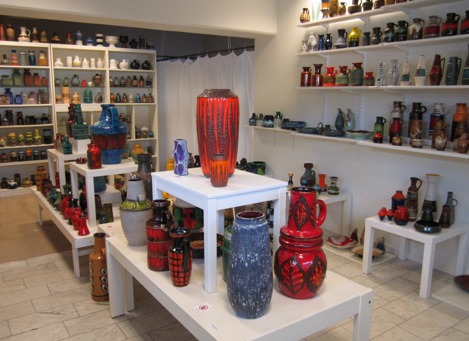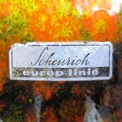Introduction
My collection of German pottery has developed during several years of searching at charity shops, flea markets and purchases on Swedish Tradera, and ebay. I bought the first was in 2008. It was a large floor vase from Scheurich, form 267-40. I was immediately struck by the bold shape and the intense colors. I bought more vases and I also tried to find information about German pottery.
It appeared, however, that there were not many books or reliable information on the internet about this pottery. Especially difficult was it to determine what year the ceramic was made. Roughly one could determine if the vase was from the 50s, 60s or 70s.
My collection grew rapidly and became so big that it was impossible to get an overview of it. What do you do with such a collection of ceramics? In the summer of 2014,I had an exhibition with about 600 pieces in my hometown Vännäs in Sweden. For this event I compiled an exhibition catalog. During the work with the catalog, I began to study the base marks and the labels that still remained on some of the pieces. I saw that the producers used several labels, some with only small changes in the lay-out, and that there was a certain systematic of the base marks.
After the exhibition, my collecting interest changed to fully focus on different labels and marks. With my growing collection as the basis combined with countless hours on the internet and with the help of the few books on the subject available, I have tried to compile a timeline for the labels of the largest manufacturers. I then combine this timeline with the various base marks. The goal is to determine the time period a piece was made on the basis of the label and/or the base mark.

The exhibition in Vännäs 2014
I have focused on the largest producers and start by presenting a timeline for Scheurich. There are still uncertainties in some of the years. I am therefore interested to obtain reliable information about the year pieces were made. Do you have information on when a vase or dish was originally purchased which confirms or change my timeline so please contact me. There are probably also some labels that I lack. Do you have a vase or dish with a label that is not in my presentation, I am interested to buy it at a reasonable price.
I want to thank my brother Anders who has helped me to find missing labels and base marks.
All photographs of labels and marks are from my own collection. You are not allowed to use photographs or pictures without my permission.
© Gunnar Rådberg
Literature & internet links
LITERATURE
Horst Makus 2005: Keramik der 50er Jahre. Formen, Farben und Dekore. Ein Handbuch. Arnoldsche Art Publisher. ISBN 3-89790-220-6.
Horst Makus, Alexandra Marx et al 2013: HEINZ AND INGRID SIERY Ceramics − Bronze − Interior Decoration. Arnoldsche Art Publisher. ISBN 978-3-89790-401-9.
Kevin James Graham 2010: West & East German Pottery Marks, Bases, Decors and Form Numbers Volume III. (On CD).
Kevin James Graham 2012: Quick Guide to German Pottery. (On CD).
Mark Hill 2012: Fat Lava. West German Ceramics of the 1960s & 70s. Third edition. Mark Hill Publishing Ltd. ISBN-10: 0-9552865-6-5. ISBN-13: 978-0-9552865-6-8.
M.P. Tomas 2006: Deutsche Keramik und Porzellane der 60er und 70er Jahre. ISBN 3-00-017329-3.
Alf Dieterle 2008: Scheurich. Trödler Das Markt- & Sammler Magazin 10/2008. Gemi Verlags GmbH Reichertshausen.
INTERNET LINKS
www.potteryandglass.forumandco.com
www.potsandpots.com
www.20thcenturyforum.com
www.Facebook: West German Pottery
www.ginforsodditiques.com
www.fatlava-schiedam.com
www.keramiksammlung.jimdo.com
I want to thank all the people who share their knowledge about German pottery on the internet forums. Special thanks to Volker Hornbostel who has contributed with a lot of information about years and decor names.

My first "Fat Lava" vase. Scheurich 267 40 by A Seide.


Two labels "Scheurich europ linie". They are not exactly the same.

Scheurich labels with timeline